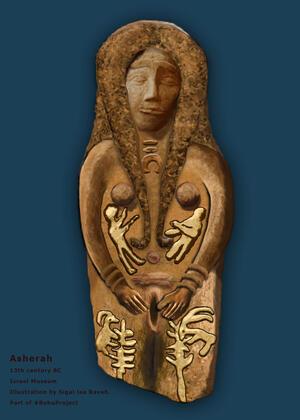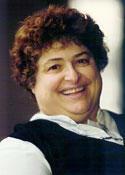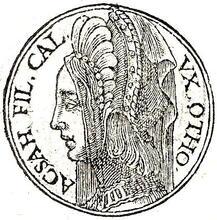Asherah/Asherim: Bible
Canaanite goddess Asherah, 13th century BCE. From the Israel Museum via Wikimedia Commons.
Asherah, along with Astarte and Anath, was one of the three great goddesses of the Canaanite pantheon. In Canaanite religion her primary role was that of mother goddess. Canaanites associated Asherah with sacred trees, an association also found in the Israelite tradition. Israel’s association of Asherah with sacred trees is repeated over thirty times in the Bible; many of these citations are stereotypically used by the biblical writers to describe sites of idolatrous worship, implying that the worship of Asherah was an apostate behavior in Israel and improper for followers of YHWH. Despite these and other references associating Asherah with apostasy, contemporary discoveries have further indicated that, at least in the opinion of some ancient Israelites, YHWH and Asherah were appropriately worshipped as a pair.
Asherah in the Canaanite Pantheon
Etymology and Biblical Connections
The Canaanite association of Asherah with sacred trees is also found in Israelite tradition. For example, one of the Canaanite epithets of Asherah, elat, “goddess,” is etymologically identical to the Hebrew word for the terebinth tree (ela). Another word for “terebinth” (alla) and two words for “oak” (elon and allon) are also closely related. Gen 2:4b–3:24 may further suggest the association of Asherah with sacred trees, since the way that Eve, “the mother of all living” (3:20), is described in the Eden story mimics in certain respects the role of the Canaanite mother goddess Asherah. If a correspondence holds, then the trees of life and of knowledge in the Eden narrative may also reflect Asherah imagery.
Most significant, though, in demonstrating Israel’s association of Asherah with sacred trees are biblical materials that describe the asherah (singular) or asherim (plural), the cult object(s) that are associated with the goddess Asherah more than thirty times in the Hebrew Bible. These cult objects are generally described as being in the shape of a pole or stylized tree. Like a pole or tree, they can be said to be planted, stood up, or erected. Conversely, when destroyed, these cult symbols can be described as being cut down, hewn down, or uprooted; they can also be said to be burned, overturned, or broken. Both the Greek and Latin translations of the Bible, moreover, render the words asherah and asherim as “grove” or “wood.”
According to the biblical record, these sacred poles or stylized trees associated with Asherah were erected by the Israelites throughout most of their history, especially during the premonarchic (tribal) period (Judg 6:25–26, 28, 30)) and during the period of the divided monarchy, both in the northern kingdom of Israel (1Kgs 14:15; 16:33; 2 Kgs 13:6; 17:10, 16; 23:15; and parallel references in 2 Chronicles) and in Judah, in the south (1 Kgs 14:23, 15:13; 2 Kgs 18:4; 21:3, 7; 23:6, 14; and parallel references in 2 Chronicles). These sacred poles were situated in various locations. In Judges 6, a sacred pole of Asherah is said to have stood beside the altar of the Canaanite storm god, Baal. The Bible also connects sacred poles with the “high places” (open-air cult sites?) and frequently mentions that they stood “on every high hill and under every green tree” (1 Kgs 14:23; 2 Kgs 17:10; 18:4; 21:3; 23:13–14; 2 Chr 14:3; 17:6; 31:1; 33:3, 19; 34:3; Jer 17:2). Both of these phrases are stereotypically used by the biblical writers to describe sites of idolatrous worship, implying, as does Judges 6, that the worship of Asherah was an apostate behavior in Israel and improper for followers of YHWH.
Worship of Asherah
Yet despite these and other references associating Asherah with apostasy (for example, Exod 34:13; Deut 7:5; 12:3; Judg 3:7; 1 Kgs 18:19), and despite the fact that the Israelites are explicitly forbidden in Deut 16:21 to erect one of Asherah’s sacred poles beside an altar of YHWH, there are multiple indications in biblical tradition that many in ancient Israel did regard Asherah’s cult icon as an appropriate sacred symbol within the religion of YHWH. For example, one of Asherah’s sacred poles stood next to YHWH’s altar at Bethel, one of the two great cult sites of the northern kingdom of Israel (2 Kgs 23:15). Another of Asherah’s sacred poles stood in that kingdom’s capital city, Samaria. The sacred pole of Samaria, moreover, which was erected during the reign of King Ahab (reigned 873–852 B.C.E.), was allowed to remain standing by the reformer King Jehu (1 Kgs 16:33; 2 Kgs 13:6), even though Jehu was generally at pains to remove all non-Yahwistic cults and cult imagery from the land. This fact suggests that Jehu perceived the sacred pole as appropriate in the worship of YHWH.
Archaeological discoveries from the late 1970s and early 1980s have further indicated that, at least in the opinion of some ancient Israelites, YHWH and Asherah were appropriately worshipped as a pair. From the site of Kuntillet ‘Ajrud, in the eastern Sinai, come three ninth- or eighth-century B.C.E. inscriptions that mention YHWH and “his Asherah” (meaning YHWH’s companion [consort?], the goddess Asherah) or “his asherah” (meaning YHWH’s sacred pole that represents the goddess Asherah and that sits in his temple or beside his altar). An eighth-century B.C.E. inscription from Khirbet el-Qom, about twenty-five miles southwest of Jerusalem, contains similar language in 1 Kgs 15:13 and 2 Kgs 18:4, 21:7, and 23:6 (with parallels in 2 Chronicles) indicate that at least during certain points in the ninth, eighth, and seventh centuries B.C.E., Asherah’s sacred pole was perceived as an appropriate icon to erect in Jerusalem, even in YHWH’s temple. Also, vessels in the temple were used to make sacrifices to Asherah (2 Kgs 23:4), and in a compound within the temple’s walls, women cult functionaries wove garments used to clothe Asherah’s cult statue (2 Kgs 23:7). Thus it appears that, although generally the biblical writers—especially certain prophets (Isa 17:8; 27:9; Jer 17:2; Mic 5:14) and the authors responsible for Deuteronomy, Judges, 1 and 2 Kings, and 2 Chronicles—regarded Asherah worship as inappropriate, at least some and possibly many in ancient Israel incorporated the goddess’s cult imagery and ritual into the cult of YHWH.
Asherah’s Cult
Unfortunately, our sources do not provide enough information to identify definitively which Israelites were particularly attracted to the worship of Asherah or the reasons for this attraction. One possibility is that in royal circles, especially in the southern capital city of Jerusalem, the cult of Asherah was particularly attractive to the king’s mother. Not only was the queen mother’s position in the palace generally paralleled by Asherah’s position as mother goddess in the heavens, but also the queen mother’s status as the wife of the king’s father suggests an affinity to Asherah’s cult. This is because southern royal ideology typically described the king’s metaphorical father as YHWH. For those ancient Israelites who saw Asherah as YHWH’s consort, this should suggest a correspondence between the queen mother, the wife of the king’s biological father on earth, and Asherah, the wife of YHWH, who was the king’s metaphorical father in the heavens.
Whether women, more generally, were more likely to be devotees of Asherah’s cult is unknown. There is some biblical evidence that does see women as particularly attracted to goddess cults (for example, women’s role in the cult of the queen of heaven, according to Jer 7:18 and 44:17–19, 25), and the various female figurines found in domestic contexts at multiple Israelite sites might also suggest this, assuming, as many scholars do, that women played an especially important role in family-centered religious activities. Nevertheless, the presence of Asherah’s cult in the Jerusalem temple and in the cult city of Bethel indicates that worship of the goddess was also appealing to men, given that it was an all-male clergy that officiated at these (and at every) Israelite religious site.
The presence of Asherah’s cult in Israel also raises questions about the nature of the monotheistic confession that is often assumed to be a core principle in Israelite faith. Generally speaking, biblical scholars assume that full-blown, radical, or philosophical monotheism came to Israel fairly late in its history, during the time of the exile in the sixth century b.c.e. Prior to this, we have abundant evidence that other gods and goddesses were worshipped in Israel in addition to (or sometimes instead of) YHWH. Yet even in these earlier materials, we sometimes see evidence of a phenomenon that comes to dominate in the exilic period: the impulse to assimilate the attributes of the many gods and goddesses of older polytheistic systems to the one god, YHWH. Language that speaks of God as mother, for example (as in Deut 32:18; Num 11:12–13; Isa 45:9–10, 49:15; 66:13), probably represents the assimilation of Asherah’s maternal characteristics to YHWH.
Ackerman, Susan. “The Queen Mother and the Cult in Ancient Israel.” Journal of Biblical Literature 112 (1993): 385–401.
Ibid. Under Every Green Tree: Popular Religion in Sixth-Century Judah. Atlanta: 1992.
Day, John. “Asherah in the Hebrew Bible and Northwest Semitic Literature.” Journal of Biblical Literature 105 (1986): 385–408.
Meyers, Carol, General Editor. Women in Scripture. New York: 2000.
Olyan, Saul M. Asherah and the Cult of Yahweh in Israel. Atlanta: 1988.
Wiggins, Steve A. A Reassessment of ‘Asherah’: A Study According to Textual Sources of the First Two Millennia b.c.e. Kevelaer, Germany: 1993.










